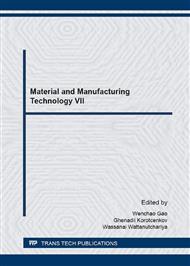[1]
M.T. Yagub, T.K. Sen, S. Afroze and H.M. Ang, Dye and its removal from aqueous solution by adsorption: A review, Adv. Colloid. Interface. Sci. 209 (2014) 172-184.
DOI: 10.1016/j.cis.2014.04.002
Google Scholar
[2]
A.M. Ferreira, J.A.P. Coutinho, A.M. Fernandes and M.G. Freire, Complete removal of textile dyes from aqueous media using ionic-liquid-based aqueous two-phase systems, Sep. Purif. Technol. 128 (2014) 58-66.
DOI: 10.1016/j.seppur.2014.02.036
Google Scholar
[3]
I. Anastopoulos and G. Kyzas, Agricultural peels for dye adsorption: A review of recent literature, J. Mol. Liq. 200 (2014) 381-389.
DOI: 10.1016/j.molliq.2014.11.006
Google Scholar
[4]
T. Zhou, W. Lu, L. Liu, H. Zhu, Y. Jiao, S. Zhang and R. Han, Effective adsorption of light green anionic dye from solution by CPB modified peanut in column mode, J. Mol. Liq. 211 (2015) 909-914.
DOI: 10.1016/j.molliq.2015.08.018
Google Scholar
[5]
Information on http: /www. ocsb. go. th/th/cms/detail. php?ID=142&SystemModuleKey=production.
Google Scholar
[6]
P.L. Homagai, K.N. Glhmire and K. Inoue, Adsorption behavior of heavy metals onto chemically modified sugarcane bagasse, Bioresour Technol. 101 (2010) 2067-(2069).
DOI: 10.1016/j.biortech.2009.11.073
Google Scholar
[7]
A. Bhatnagar and M. Sillanpää, Utilization of agro-industrial and municipal waste materials as potential adsorbents for water treatment—A review, Chem. Eng. J. 157 (2010) 277-298.
DOI: 10.1016/j.cej.2010.01.007
Google Scholar
[8]
A. Geethakarthi and B. R. Phanikumar, Adsorption of reactive dyes from aqueous solutions by tannery sludge developed activated carbon: Kinetic and equilibrium studies, Int. J. Environ. Sci. Tech. 8 (2011) 561-570.
DOI: 10.1007/bf03326242
Google Scholar
[9]
S. Noreen and H.N. Bhatti, Fitting of equilibrium and kinetic data for the removal of Novacron Orange P-2R by sugarcane bagasse, J. Ind. Eng. Chem. 20 (2014) 1684-1692.
DOI: 10.1016/j.jiec.2013.08.017
Google Scholar
[10]
Y. Jiang, H. Pang, and B. Liao, Removal of copper(II) ions from aqueous solution by modified bagasse, J. Hazard. Mater. 164 (2009) 1-9.
DOI: 10.1016/j.jhazmat.2008.07.107
Google Scholar
[11]
X. Peng, D. Huang, T. Odoom-Wubah, D. Fu, J. Huang and Q. Qin, Adsorption of anionic and cationic dyes on ferromagnetic ordered mesoporous carbon from aqueous solution: Equilibrium, thermodynamic and kinetics, J. Colloid. Interf. Sci. 430 (2014).
DOI: 10.1016/j.jcis.2014.05.035
Google Scholar
[12]
G.R. Mahdavinia, A. Massoudi, A. Baghban and E. Shokri, Study of adsorption of cationic dye on magnetic kappa-carrageenan/PVA nanocomposite hydrogels, J. Environ. Chem. Eng. 2 (2014) 1578-1587.
DOI: 10.1016/j.jece.2014.05.020
Google Scholar


